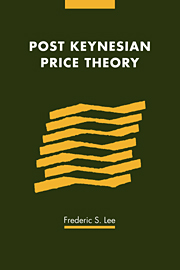Book contents
- Frontmatter
- Contents
- List of figures and tables
- Acknowledgments
- Introduction
- Part I The doctrine of administered prices
- Part II The doctrine of normal cost prices
- Part III The doctrine of mark up prices
- 7 The origin of the doctrine of mark up prices: Michal Kalecki's microanalysis
- 8 Kalecki's microanalysis and the war years
- 9 Kalecki and the Cambridge contributions
- 10 Josef Steindl and the stagnation thesis
- Part IV The grounded pricing foundation of Post Keynesian price theory
- Appendix A Studies on cost accounting and costing practices
- Appendix B Studies on pricing
- Bibliography
- Index
9 - Kalecki and the Cambridge contributions
Published online by Cambridge University Press: 22 September 2009
- Frontmatter
- Contents
- List of figures and tables
- Acknowledgments
- Introduction
- Part I The doctrine of administered prices
- Part II The doctrine of normal cost prices
- Part III The doctrine of mark up prices
- 7 The origin of the doctrine of mark up prices: Michal Kalecki's microanalysis
- 8 Kalecki's microanalysis and the war years
- 9 Kalecki and the Cambridge contributions
- 10 Josef Steindl and the stagnation thesis
- Part IV The grounded pricing foundation of Post Keynesian price theory
- Appendix A Studies on cost accounting and costing practices
- Appendix B Studies on pricing
- Bibliography
- Index
Summary
There were numerous references to Kalecki's microanalysis during the early post-war years. In general, they summarized Kalecki's pricing analysis and its relation to private enterprise and profits, income distribution, and price policies. Although no significant theoretical developments occurred at this time, the economists generally interpreted Kalecki's degree of monopoly in terms of price elasticity of demand, while at the same time noting that it was an intermediate concept which was based on a range of more basic influences. Moreover, economists continued to discuss the relationship between Kalecki's pricing analysis and full cost pricing, which led to considerable progress towards formalizing the monopoly–full cost pricing model. Finally, there were various comments throughout the period, and on both sides of the Atlantic, to the effect that enterprises preferred satisfactory or reasonable profits, sought security, and did not aim for profit maximization; that enterprises' pricing policies produced empirically stable gross profit margins; that marginal cost curves were mostly linear and deviated little from average direct costs; and that oligopoly conditions undermined the determinant nature of the enterprise demand curve. This interlude in the development of the mark up prices doctrine had come to an end by the early 1950s. Although there was the publication of Kaldor's memorandum on advertising (Kaldor, 1950) and Ron Hieser's analysis of the degree of monopoly (Hieser, 1952), the development of Kalecki's microanalysis did not really begin until 1954 with the publication of Theory of Economic Dynamics (Kalecki, 1954).
- Type
- Chapter
- Information
- Post Keynesian Price Theory , pp. 165 - 185Publisher: Cambridge University PressPrint publication year: 1999
- 8
- Cited by



